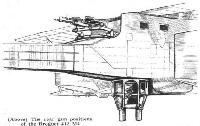Breguet Bre.270 и Bre.410
<...>
На основе Bre.270 была спроектирована серия экспериментальных двухмоторных бипланов Bre.410, получивших в наследство от предшественника шасси и хвостовую балку. Самолет вначале имел определенный успех, ВВС Франции разместили на него заказ, планируя использовать машину в качестве многоцелевого самолета, способного выполнять задачи тяжелого истребителя, бомбардировщика и разведчика. Однако из-за необходимости существенного внесения изменений в конструкцию тему закрыли.
<...>
Показать полностьюShow all
Flight, February 1934
The Breguet 41
THE Breguet 41 is classed by its manufacturers as a multi-seater fighter, reconnaissance machine and bomber, although it is usually referred to as "multiplace de combat." The aircraft is a single-bay sesquiplane braced by a single pair of "N" interplane struts on each side of the fuselage. The wings have a small negative stagger. The outer sections of the upper main plane are attached to a centre section on top of the fuselage, while the lower plane, which is in one piece, is built round a single spar. Trailing edge flaps are fitted to the upper planes. Just behind the pilot's cockpit above the leading edge of the top wing is a small auxiliary aerofoil, the purpose of which is to correct any disturbance in the air flow caused by the cockpit.
The main structure of the 41 differs from that of the better known 27 machine in that it is not built of a frame of two box girders joined by a third member, but consists of a fuselage which fills the entire gap between the wings, at the end of which is a box spar which carries the tail unit. The main portion of the fuselage is built up of several transverse frames connected by four longerons and diagonal members, the whole being covered by alloy sheeting riveted to the framework. The exceptionally clean undercarriage, which is of a similar type to that used on the well-known Breguet 27, may be seen in the accompanying illustration.
The nose of the fuselage is transparent and contains an enclosed turret for the forward gunner. This turret is attached to and revolves with the gun ring in a similar way to the "parrot cage" used on our own Bristol 120. Twin guns (Lewis or similar type) protrude through an opening in the turret. Contrary to some reports, fixed guns are not fitted to the Breguet 41. An open cockpit for the pilot, who is seated on the left-hand side of the fuselage, is situated just in front of the leading edge of the top plane. An auxiliary pilot's position fitted with a hinged window is located in the fuselage. The navigator's position is to the right of and below the pilot's seat beneath which wireless is installed in a position easily accessible to the navigator, and the bomber's position is on the port side beneath the top plane. An efficient system of communication is provided between the pilot and the other members of the crew. Behind the wings is a well sheltered position for the rear gunner with a mounting for twin guns. A very excellent field of fire is obtained in this position, as the spar which supports the tail unit, unlike the conventional type of fuselage, is of a very small cross section. Another position for a down ward firing gun may be provided beneath this position.
A variety of engines may be installed, and the aircraft has a separate type number for each installation. When fitted with two Hispano Suiza 12 H.B. 500-h.p. engines the type is known as the 41-1; with two Hispano-Suiza 12 N.B. engines of 650 h.p., as the 41-2; with two Hispano-Suiza 12 Y brs. engines (840 h.p. at 13.120 ft.), as the 41-3; and with two Gnome-Rhone 14 K brs. geared and supercharged radial engines, as the 41-4. With its concentration of mass, this machine has quite remarkable powers of manoeuvre, and has been ordered in large quantities for the "Armee de l'Air."
THE BREGUET 41 TYPES
Breguet 41-1
Weight empty 6,640 lb.
Weight loaded 10,100 lb.
Maximum speed 153 m.p.h.
Climb to 13,120 ft. 11 min.
Breguet 41-2
Weight empty 7,002 lb.
Weight loaded 13,640 lb.
Maximum speed 165 m.p.h.
Climb to 13,120 ft. 10 min. 30 sec.
Breguet 41-3
Weight empty 7,230 lb.
Weight loaded 13,720 lb.
Speed at 13,120 ft. 196 m.p.h.
Climb to 13,120 ft. 7 min.
Breguet 41-4
Weight loaded 13,400 Ib.
Speed at 13,120 ft. 189-5 m.p.h.
Climb to 13,120 ft. 7 min. 3 sec.
Показать полностьюShow all
Flight, November 1934
THE FOURTEENTH PARIS AERO SHOW
THE EXHIBITS DESCRIBED
Heavy Military Types
<...>
Louis Breguet's type 41 M4 is another of the General-Purpose aircraft which France encourages. This machine, developed from the famous ''Tout Acier," is a sesquiplane fitted with two Gnome-Rhone 14 Krsd. engines, while the 41 M3 has two Hispano 12 Ydrs. engines. The speed is given as 186 m.p.h., and the climb to 13,000ft. occupies nine minutes. The range is 750 miles.
<...>
Показать полностьюShow all


